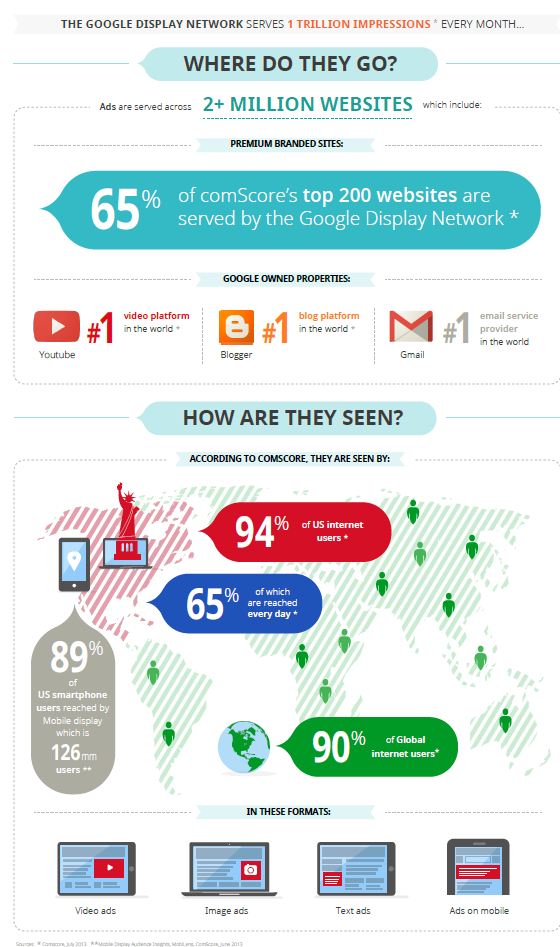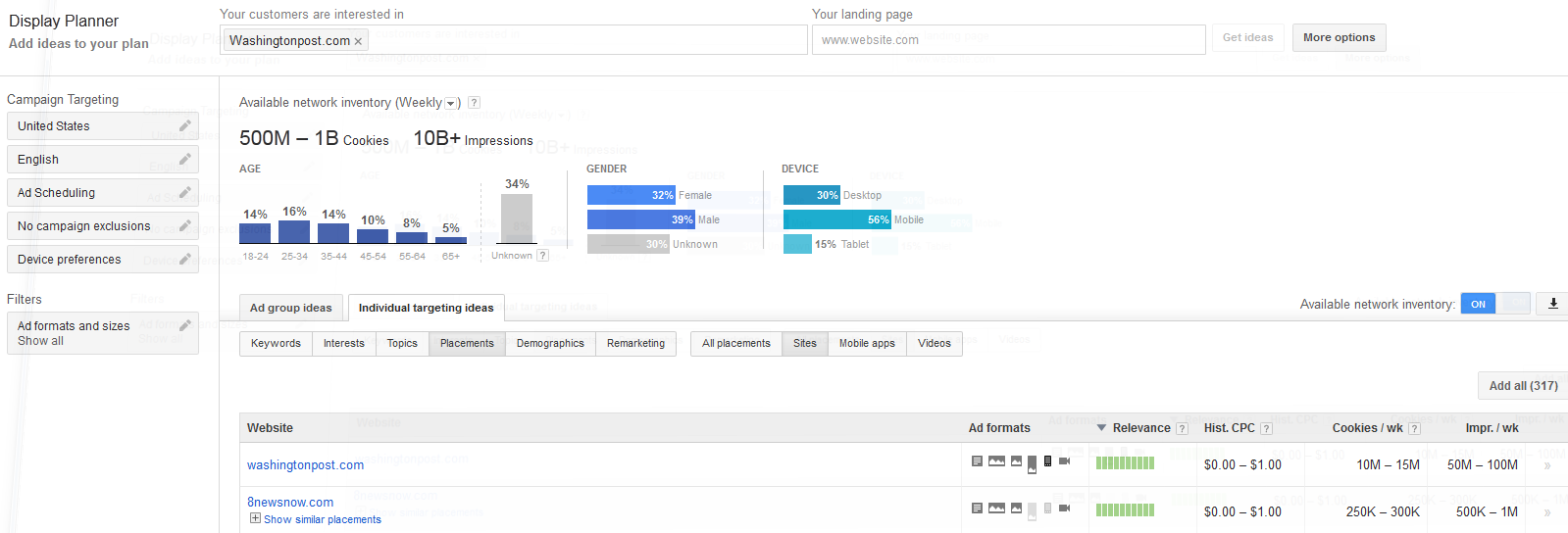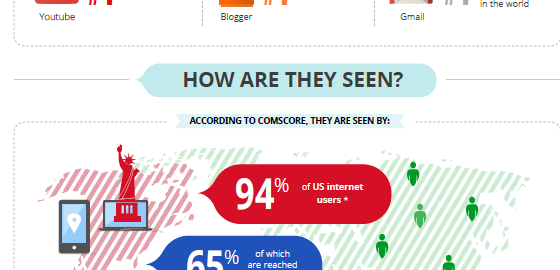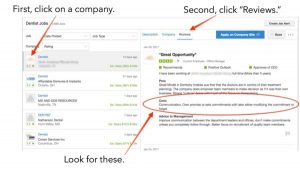If you’re new to AdWords, or you’re fulfilling your New Year’s resolutions to finally get a handle on your AdWords account, one of your first questions will be deciding how to leverage the search and display networks. While the Search network can be a great way to catch customers who are actively searching for your product or service, it can be difficult for new and niche businesses to reach people who aren’t already familiar with their product and may not be actively searching for them on Google. For advertisers looking to generate that initial interest in their product, display advertising is a great way to get in front of the most prospective customers at minimal cost.
AdWords advertisers should be happy to hear that the Google Display Network has, by far, the largest reach of any display network in the world. 90% of global internet users are reached by GDN, including 94% of all US internet users – 64% of which are reached every day – and 89% of US smartphone users. The Google Display network is your fast track to show your ad on 120 of the top 200 trafficked websites, including the #1 video platform, YouTube; the #1 blog platform, Blogger; the #1 email service, Gmail; and reach to 50 billion apps downloaded via Google Play. In total, the Google Display Network serves 2+ trillion ad impressions each month to 2.5 billion internet users across 2+ million websites.
 Source: Think With Google / Data: Comscore, 2013
Source: Think With Google / Data: Comscore, 2013
Targeted Audiences on the Google Display Network
Advertisers have literally millions of different targeting options to find new customers on the Google Display Network, and it can first seem overwhelming to choose the right targets for your display campaign. However, each targeting method effectively falls into one of two camps:
- Website-based targets: Which target a set of websites, based on some criteria, and show ads to all users on those sites.
- User-based targets: Which target a set of users, based on some criteria, and shows them ads to on all sites they visit on the Google Display Network.
Website Based Targets: Target all users who visit these websites.
Managed Placements: A managed placement target isthe most direct way to target a website. Simply choose the website(s) or pages you want to show your ad and you’re done! You can use the Display Planner Tool to get traffic and cost estimates for a certain domain, see which ad formats the site supports, and get ideas for other similar placements.

Topic Targeting: Topic targeting on the Google Display Network allows you to target all sites and pages about a certain pre-defined topic. Topic targeting is similar to managed placements, but considerably less restrictive. Topic targeting allows advertisers to reach a wider audience than they can reach with just managed placements.

Major categories of topic targeting available on GDN; subcategories can be more specific.
Keyword Contextual Targeting: Keyword contextual targeting on GDN is similar to topic targeting, but less restrictive. It’s perfect if your topic isn’t one of the hundreds defined by Google in the topic targeting. Simply create a list of keywords and your ads will be matched to page that have contextually similar content.
User-Based Targets: Target certain users across all the sites they visit on the Google Display Network.
Remarketing: Remarketing is one of GDN’s most powerful targeting tools. Google display remarketing allows you to serve ads to previous visitors of your site as they navigate the web, keeping your product and brand at the front of their mind, even after leaving you site. Remarketing also allows you to engage with high-value visitors, such as those whom have purchased from you in the past, viewed key pages (such as product or pricing pages), or have had the most engagement on your site, differently than those whom have not.
Similar Audiences: Similar audience targeting allows you to attract new users to your site who have similar browsing and search behavior as those already on your remarketing lists. Similar audience targeting is a great next step for those advertisers who have seen success with remarketing to find their next best audience to target.
In Market Audiences: In market audience targeting shows your ad to users whose search and internet browsing behavior indicates that they may be “in market” for a certain product or service. For example, a user whom starts repeatedly searching for “Temp Jobs” and starts visiting related postings on Monster.com could be identified as “in market” for a temporary or seasonal job. In market audience targeting works best for products or services that have longer buying and researching cycles.
Interests: Interest targeting matches your ads to users who recently started viewing sites of the same topic. It’s ideal for finding new customers whom have just begun to be interested in something. Consider matching your offer and promoting beginner or novice level products or services for these casual users.

Major interest categories on GDN; subcategories can be more specific.
Affinity: Affinity targeting is similar to interest targeting, but it matches your ads to users whom habitually visit sites of the same topic. Think of them as long-term interests. These are your more experienced, hardcore users. Consider matching your offer and promoting more advanced or specialty products or services for these experienced users.

Major affinity targets on GDN.
Demographic Targeting on the Google Display Network
In addition to the various website- and user-based targeting methods, we can also layer on demographic targets for a user’s gender, age range, and parental status. Advertisers can either exclude or create custom bid adjustments for users based off these demographics. The implications for certain advertisers with a strong homogenous key demographic are clear. If your industry leans heavily on one gender, age range, or parental status (say, women’s clothing, retirement services, or baby care), demographic targeting may be a powerful tool for you to leverage.

The Google Display Network is a powerful medium to expose your brand to a wide range of new users who might not yet be searching on Google for your product. Sophisticated website and user based targets as well as layered demographic targeting allows you to experiment and find your audience, no matter how niche it is. Be sure to plan ahead though! The Google Display Network has over 3,000 predefined targeting options and is adding more all the time. We’ve compiled the most up to date list of GDN targets for download here to help you best plan display efforts and find new successful methods of targeting.
(313)
Report Post







